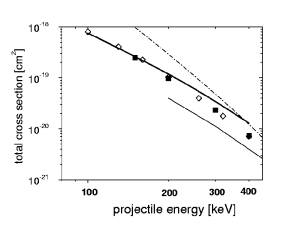
Figure 1:
Total cross section for TI: present, thick solid line;
CDW-Born IEM, dashed-dotted line; RIA-4B thin solid line;
COLTRIMS, solid squares; Shah and Gilbody, open diamonds.
TRANSFER IONIZATION FOR 100-400 keV INCIDENT ENERGY IN p-He COLLISIONS
H.C. Tseng1,3 , W. Fritsch2 and C.D. Lin1
1) Department of Physics, Kansas State University, Manhattan, Kansas 66506-2601
2) Bereich Theoretische Physik, Hahn-Meitner-Institut, D-14109 Berlin, Germany
3) Department of Physics, Chung Yuan Christian university, Chung Li, Taiwan 32023
The collision of protons (p) with helium (He) is a fundamental two-electron system involving electron-electron correlation. Recently, a kinematically complete experiment for the transfer ionization (TI) cross section between 0.15 and 1.4 MeV has been measured by cold target recoil ion momentum spectroscopy (COLTRIMS)1. The TI cross sections from COLTRIMS agree well with the experimental data of Shah and Gilbody2 for overlapping energies between 150 and 400 keV. There exists several theoretical calculations3,4 for TI cross sections with different degrees of theoretical sophistications but they show obvious discrepancies with experiments in the energy region between 150 and 400 keV.
In this report we used the semiclassical impact parameter close-coupling approximation to treat the collision of protons with helium atom by expanding the time-dependent two-electron wave function in terms of eigenstates of helium atoms, of two-center atomic states representing transfer ionization channels, and of atomic states representing single capture accompanied by target excitation channels, such that all the dominant inelastic channels are included in the basis functions. Pseudostates centered on the target atom are used to represent the ionization channels. The electron-electron correlation effect is fully accounted for throughout the collision.
We have also performed the calculation within the independent particle model (IPM)5 where each electron of the helium atom is assumed to be in a Coulomb potential Vt=-Zeff/r with an effective charge Zeff such that the binding energy of each electron is half of the double ionization energy. In view of the result from IPM that single capture cross section to H(1s) with helium ion in the He+(1s) state accounts for more than 90% of total single capture cross section between 100 and 400 keV, we included only capture to H(1s) state in our two-electron two-center calculation. In Figure 1, our results of TI cross sections agree well with the experimental data1,2 between 100 and 300 keV, but deviation begins to appear at 400 keV.
Figures:

Figure 1:
Total cross section for TI: present, thick solid line;
CDW-Born IEM, dashed-dotted line; RIA-4B thin solid line;
COLTRIMS, solid squares; Shah and Gilbody, open diamonds.
References:
l) V. Mergel et al., Phys. Rev. Lett. 79, 387 (1997).
2) M. B. Shah and H. B. Gilbody, J. Phys. B, 18, 899 (1985).
3) R. Gayet and A. Salin, Nucl. Instrum. Methods Phys. Res., Sec B 56/57, 82 (1991).
4) Dz. Belkic, Nucl. Instrum. Methods Phys. Res., Sec B 99, 218 (1995); Phys. Scr.53, 414 (1996).
5) R. Shingal and C. D. Lin, J. Phys. B, 24, 251 (1991).
This work was supported by the
Chemical Sciences, Geosciences and Biosciences Division,
Office of Basic Energy Sciences,
Office of Science,
U.S. Department of Energy.
H.C.T. was also supported in part by the National Science Council, Taiwan
Submitted to ICPEAC 2001, July 2001 in Santa Fe, NM.
This abstract is also available in Postscript or Adobe Acrobat formats.
|
|